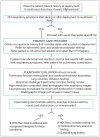Deployment-Related Lung Disorders
Abstract
Deployment in southwest Asia is associated with a wide range of respiratory disorders related to tobacco use and to workplace and environmental exposures. Physicians should carefully consider deployment history when assessing and treating veterans with lung disorders.
Conflict of interest statement
Author disclosures The authors report no actual or potential conflicts of interest with regard to this article.
Figures




Similar articles
-
Deployment-Related Lung Disorders.Fed Pract. 2015 Jun;32(6):32-38. Fed Pract. 2015. PMID: 30766070 Free PMC article.
-
Pulmonary Function and Respiratory Health of Military Personnel Before Southwest Asia Deployment.Respir Care. 2017 Sep;62(9):1148-1155. doi: 10.4187/respcare.05438. Epub 2017 May 2. Respir Care. 2017. PMID: 28465382
-
Study of Active Duty Military Personnel for Environmental Deployment Exposures: Pre- and Post-Deployment Spirometry (STAMPEDE II).Respir Care. 2019 May;64(5):536-544. doi: 10.4187/respcare.06396. Epub 2019 Jan 8. Respir Care. 2019. PMID: 30622173
-
Environmental Exposures and Asthma in Active Duty Service Members.Curr Allergy Asthma Rep. 2019 Sep 4;19(9):43. doi: 10.1007/s11882-019-0873-3. Curr Allergy Asthma Rep. 2019. PMID: 31485825 Review.
-
Emerging spectrum of deployment-related respiratory diseases.Curr Opin Pulm Med. 2015 Mar;21(2):185-92. doi: 10.1097/MCP.0000000000000143. Curr Opin Pulm Med. 2015. PMID: 25575366 Review.
Cited by
-
Patient motivations for non-adherence to lung cancer screening in a military population.J Thorac Dis. 2020 Oct;12(10):5916-5924. doi: 10.21037/jtd-20-1841. J Thorac Dis. 2020. PMID: 33209424 Free PMC article.
References
-
- Rose C, Abraham J, Harkins D, et al. Overview and recommendations for medical screening and diagnostic evaluation for postdeployment lung disease in returning US warfighters. J Occup Environ Med. 2012;54(6):746–751. - PubMed
-
- Morris MJ, Lucero PF, Zanders TB, Zacher LL. Diagnosis and management of chronic lung disease in deployed military personnel. Ther Adv Respir Dis. 2013;7(4):235–245. - PubMed
-
- Siegel R, Ma J, Zou Z, Jemal A. Cancer statistics, 2014. CA Cancer J Clin. 2014;64(1):9–29. - PubMed
LinkOut - more resources
Full Text Sources
